
Macular degeneration
Macular degeneration
Brigitte Jonczyk, alternative practitioner, Rastede
Dear Bioresonance Therapists,
My name is Brigitte Jonczyk, I have been a self‐employed alternative practitioner with a focus on bioresonance therapy for 15 years. I work with eight BICOM optima devices. In 2013 I gave a lec‐ ture on macular degeneration at the user congress in Fulda (RTI issue 37). Now the company REGUMED approached me and asked me to present again on the topic.
I will therefore incorporate my new findings and the innovations of the last 10 years into this presentation.
Again and again my patients confront me with the diagnosis “age‐related macular degeneration.” Therefore a few years ago I began to take a more interest in this widespread dis‐
ease of the eye. In the meantime, bioresonance therapy has become an integral part of our thera‐ pies ‐ also for this particular disease.
Macular degeneration develops over years almost without symptoms. In the final stage there is a rapid and significant deterioration of vision up to complete blindness. A promising approach in therapy is the combination of conventional and complementary medicine. Especially at the begin‐ ning of this disease, it is possible to stop the progression of the disease.
My explanations in this framework deal exclusively with age‐related macular
degeneration (AMD). Macular degeneration of other causes, for example due to high myopia (my‐ opic macular degeneration) as well as genetics, toxins or due to the side effects of drugs (e.g. rheumatism drugs, some psychopharmaceuticals), are not discussed here. Such damage to the macula differs from AMD in its development, so that the therapy approaches described here are not transferable to them without further amendment. Complementary medicine offers possibili‐ ties to support, but the choice of the appropriate therapy must always be considered for the indi‐ vidual case.
In Germany, more than 3 million people suffer from this disease and tens of thousands more every year. The disease usually appears after the age of 50, then the incidence increases exponen‐ tially. AMD is the leading cause of blindness in industrialized countries today. It causes 32% of new blindness, followed by glaucoma and diabetic retinopathy, both at 16%. Only for certain forms of wet AMD do conventional medical treatments exist.
Macular degeneration
The term macular degeneration is used to describe a group of diseases of the eye that affect the macula lutea (“the point of sharpest vision”) ‐ also known as the “yellow spot” ‐ of the retina and are

associated with a gradual loss of function of the tissue located there. In this central reti‐ nal area particularly active metabolism occurs, the degradation prod‐ ucts of which are disposed of by the underlying tissue layer, the so‐ called pigment epithelium.
With advancing age, this process can be disturbed, leading to deposits under the retina and further loss of function. This is called “age‐related (or senile) macular degeneration” or “AMD” or “ARMD” for short.
There are two forms of macular degeneration. A dry, very slowly pro‐ gressing form, and a wet, fast progressing form. 90 % of patients are af‐ fected by the dry form, and about 10 % by the wet form.
The consequence of both forms is that one sees a blurring in the center of the visual field, vision is distorted and one may also perceive a dark spot or a fading of colors. Since only the central area of the retina, i.e. the macula, is affected, the outer visual field remains intact. This means that the patient can see a clock, for example, but may not be able to tell the time. The first visual function to be impaired is reading, as well as the recognition of faces.
Amsler grating with normal central visual field
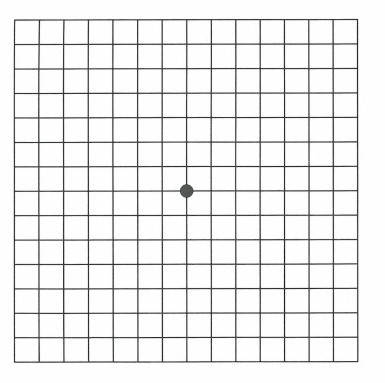
Fig. 1
Possible appearance in age‐related macular degeneration
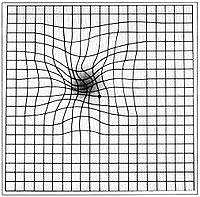
Even if mild symptoms such as distorted vision or a reduction in visual acuity occur, an ophthal‐ mologist should be consulted as soon as possible.
For early diagnosis, a test with the so‐called Amsler grid is usually performed. This simple tool is easy to use in practice and makes the phenomena described particularly visible.
During the test, it is important that you test both eyes separately and completely cover the other eye.
Modern ophthalmology makes it possible to detect the disease very early. Among other things, high‐resolution fluorescence microscopic techniques are used to visualize the fundus of the eye in the micrometer range, whereby further diagnostically relevant information can be obtained. The early diagnosis of dry macular degeneration is important to initiate a targeted holistic therapy as early as possible.
However, my motto here is also: Prevention is better than cure. A holistic prophylactic approach aims to promote blood circulation, regeneration and reduce inflammatory influences in the entire organism. And what better method to treat with than bioresonance therapy.
Therapy measures are:
Tissue detoxification
Deacidification
Elimination of environmental toxins
Reduction of oxidative stress through targeted use of micronutrients and dietary changes (sufficient drinking quantity)
Dry macular degeneration and its causes
The dry (atrophic) form accounts for approximately 90% of cases, but only 5 to 10% of blindness is caused by AMD.
Dry AMD starts when extracellular materials and metabolic waste products (lipofuscin) are depos‐ ited under the retina (drusen), as well as due to impaired blood flow to the choroid. In advanced stages it may also lead to atrophy of the retinal pigment epithelium. Usually progression is slow and insidious. Since this often occurs below the point of sharpest vision, it can sometimes lead to a rapid loss of vision as well as protrusion of the center of vision. This is then noticeable as dis‐ torted vision and a gradual loss of visual acuity.
Wet (exudative) macular degeneration and its causes
If the reduced supply of oxygen, vitamins and other vital substances persists over a longer period of time, a messenger substance is released from the blood (VEGF = vascular endothelial growth factor, or angiogenesis factor for short).
Its formation is stimulated by the change in the fracture membrane and the pigment layer. The number of drusen present and the inflammatory processes triggered by them also seem to be co‐ determinants of its extent. With the aim of improving blood flow, the messenger VEGF induces the formation of new vessels. Vessels, often invisible to the ophthalmologist, grow from the bottom of the blood‐supplied choroid to the macula. The visual pit is free of vessels, because vessels would interfere with the free optical image at this point. The newly formed vessels are leaky and porous. Tissue water and blood flow into the retinal layers and push the nerve cells apart. In the dry state of AMD, the nerve tissue, which is poor in connective tissue, was already forced apart by the un‐ derlying drusen. Therefore, fluid can spread here relatively unhindered.
The inevitable consequence is a swelling of the center of the retina (so‐called macular edema) with destruction of the impulse conduction. This process can occur within hours. The dry age‐re‐ lated macular degeneration has now become wet age‐related macular degeneration.
Fig. 4: Comparison of intact retina (left), wet AMD, and altered retina (right)
The most important influences are:
· Mitochondrial dysfunction, if applicable
Carbohydrate metabolism disorder*, if applicable
· Observation of the patient’s nutritional form**
Increasing exposure to sunlight
Decreasing performance of the pigment layer
Decreasing nutrient and vitamin supply
Decreasing blood flow and arteriosclerosis
*Logi diet: The Logi diet is a low‐carbohydrate form of nutrition. It is especially for patients with a carbohydrate metabolism disorder.
**I recommend in my practice: Clean Eating “clean, pure food” or “natural food”. Clean eating fo‐ cuses on eating, mainly natural, fresh, whole foods ‐ preferably in organic quality.
Therapeutic fasting and interval fasting are also highly recommended.
AGE
AGEs (advanced glycation end products) are a particular burden of slagging. These are non‐de‐ gradable chemical compounds of proteins and sugars. This glycosylation (technical term for chemi‐ cal reaction of sugar and protein) can take place in all tissues of the human body.
AGEs are associated with various ocular diseases (e.g. cataract, retinal diseases and also macular degeneration). They can be detected increasingly in lipofuscin deposits of the retinal pigment epi‐ thelium, in drusen and in Bruch’s membrane. At this site, enzymes inhibit the degradation of cellu‐ lar waste products and promote inflammatory reactions.
Referring to the special problem of macular degeneration, we can use bioresonance therapy to improve waste removal from the pigment layer. The blood should be made more flowable, the elasticity of the vessels should be improved and if possible calcifications of the vessel walls should be dissolved and damaged visual cells should be regenerated.
AGEs enzymes inhibit to degrade cell degradation products:
Burdens due to heavy metals
Pesticide loads
Vegetative dysfunction
Acid‐base balance
The regulation of blood flow to the eye
Two extensive vascular networks provide a generous blood supply to the retina (see Fig. 2).
The first retina is supplied by the central retinal artery and the retinal vasculature, which branches out inside the eye on the retina, coming very close to the macula but sparing the central portion, the fovea.
The second vascular network is the so‐called choroid. It supplies the retina from the outside and thus compensates for the most part for the absence of vessels in the fovea. The choroid is ex‐ tremely rich in vessels and has the highest blood flow in the organism. The blood flow to the cho‐ roid and retina is controlled in different ways.
Retinal vessels are subject to autoregulation, by which the blood flow of the tissue can be adapted to the current situation. The vessel width is regulated by biochemical substances (e.g. histamine, prostaglandins, endothelin etc.). The disturbance of the autoregulation of the retinal vessels is the subject of many current studies, since in many eye diseases it is precisely this autoregulation that is disturbed. In contrast, the choroid is regulated by the autonomic nervous system. Here, stress and tension have a particularly negative effect on the blood flow, since under the influence of stress hormones the vessels are constricted and the blood flow is reduced.
The compelling consequence of this is that patients with AMD should definitely also deal with their psychological situation in order to find ways to reduce tension and stress in everyday life. In addition, we can influence the autonomic nervous system and autoregulatory mechanisms very well via bioresonance therapy.
The retina, especially the macula, reacts to the smallest changes in the blood flow situation due to its distinct metabolism. On the one hand, the macula is not optimally supplied with oxygen, vita‐ mins and nutrients, and on the other hand, waste products are not disposed of effectively enough. As a consequence, deposits of unusable, partly toxic substances are formed in and under the pig‐ ment layer. In addition, they are also formed during the degradation of the used photoreceptors, which disturb the function of the pigment epithelial cells with increasing quantity and can lead to a premature death of the same.
The complex interrelationships in relation to the retinal metabolism give an idea of how many in‐ terrelationships we can positively intervene in. In hardly any other organ than the eye do we see just how crucial the overall situation of the body is for the health of the milieu.
Bioresonance therapy should already be started in the dry stage of the disease. The holistic ap‐ proach is essential. The purpose of all these efforts should be to prevent the transition of the dis‐ ease into its wet form or to delayed it for as long as possible.
The detailed individual information is very important, because many patients still have so much visual acuity that they do not feel the need to do anything for their health as a preventive meas‐ ure.
Recent research results indicate that age‐related macular degeneration, like many other diseases, is due to inflammatory substances produced in the metabolism.
The holistic approach of detoxification, purification and metabolism optimization recommended so far aims exactly at the reduction of these pro‐inflammatory substances and is therefore more important than ever!
Advice such as regular exercise, preferably in fresh air, a balanced diet rich in bioavailable basic substances and antioxidants, a healthy portion of sleep and reduction of stress influences should be explained to the patient in this context.
Drinking 1.5 ‐ 2 liters of fluid daily keeps the basic system clean and is in itself a detoxification measure.
The overall bioenergetic concept
Practical approach in our practice
Patient contacts us
Sending of a detailed medical history sheet
Patient returns the questionnaire
Evaluation of the anamnesis sheet
Initial consultation and initial examination ‐ Bioenergetic examination with the bio‐tensor
Basic stresses, g. milk, wheat, egg
Candida albicans
Heavy metal contamination (cadmium, amalgam, palladium)
Vaccine stresses
Virus stresses
Bacterial stresses
Parasitic stresses
Chemical exposure (formaldehyde, cadmium, pesticides, )
Food additives
Drug stresses
Detection of metabolic deficiencies:
Disturbance of the acid‐base balance
Disturbance of the vitamin balance
Disturbance of the mineral balance
Liver meridian disorder
Disturbance of the gallbladder meridian
Dysbacteria (intestinal flora)
Disturbance in the small intestine flora (Vitamin B12 absorption)
Disorder of the gastric mucosa (intrinsic factor)
Fermentation and putrefaction
Protein decomposition substances and their stresses
Pancreatic metabolism disorder
Disturbance of the fat metabolism
· Disturbance of the carbohydrate metabolism
Disturbance of the protein metabolism
Exposure to vaccinations/pathogens/metals
Teeth
Rejection disorders (KPU/HPU)
Viral loads
Bacterial loads
Heavy metal contamination
Mitochondrial dysfunction (according to the latest findings, I check every patient for mito‐ chondrial dysfunction. This is because the retina including the optic nerve is an outpost of the brain. It has the highest mitochondrial density. If this system is not considered, the pa‐ tient cannot be brought into a state of regulation.
In the medical history, focus is also put on the following diseases, all with regard to macular degeneration:
High blood pressure or fluctuating blood pressure
Heart attack and/or stroke, also in family members or relatives
Hearing loss, tinnitus
Dizziness
Arteriosclerosis and/or occlusion of the carotid artery
Circulatory disorder in the extremities (cold feet, cold hands)
Diabetes mellitus
Macular degeneration never occurs in isolation in an otherwise healthy body.
Also, of interest are:
Eating habits
Recreation
Dealing with environmental toxins
Social environment
Mental condition
Unresolved emotional conflicts
Pent up aggression
Persistent stressful situations
Smoking, also passive smoking, alcohol consumption
Drinking quantity
Medication intake
The following steps are to be adapted to the respective patient and his situation.
Basic therapy
After conductance testing for energy balancing and to tune up the body
Elimination of therapy blockades
Spinal blockades, especially C2, are often coupled with eye diseases (possibly indication for manual therapy/osteopathic treatment)
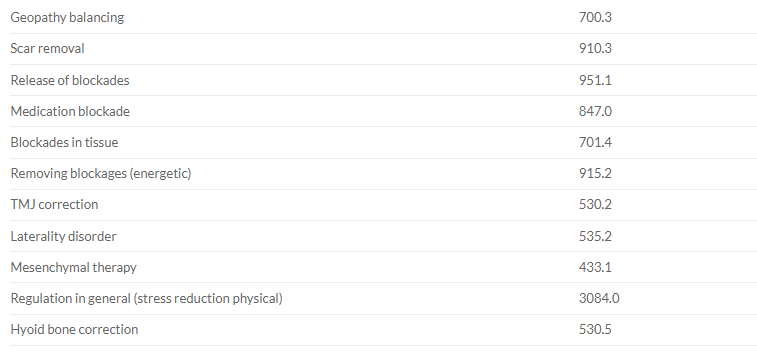
Chakra therapy
Chakras are very important and effective in age‐related macular degeneration.
The peripheral energy centers of the organism can lead to disturbances that can have physical, ener‐ getic, regulatory, emotional and mental effects and can lead to blockages.
Testing and therapy is described in therapy manuals and should be used as a stand‐alone therapy early on.
1.Meridian/organ related follow‐up therapy
5‐Elements‐Teaching
The eye is a component of the liver meridian. Eye diseases can therefore be caused in the area of the liver meridian or in the area of the gallbladder meridian which is coupled with it.
For example, hip joint problems, liver diseases or root inflammation of the eye tooth, but also scars in the course of the affected meridian or incompatible materials in prostheses (hip joint, knee joint prostheses, tooth fillings) are conceivable as troublemakers.
On the mental level, pent‐up aggression and anger damage the gallbladder meridian and can thus indirectly cause eye problems.
These blockages can also be removed very well with bioresonance therapy.
According to meridian test values (EAP) of the excretory organs: Stabilization and opening of the excretory organs
Organ specific meridian therapies
Programs 200 ‐ 391 ‐ Time and meridian testing; see test kit manual (CTT)
2.Indication‐related follow‐up therapy
Frequently:
Lymphatic activation, Liver detoxification, Kidney stimulation, Mycosetherapy
Mycoses
Pathological fungal colonization of the gastrointestinal tract with Candida albicans leads to further slagging of the basic substance, stresses the liver and leads to a disturbance of the intestine‐associated immune system. It should therefore be treated consistently.
Acid‐base balance
Acidosis is an important trigger for the slagging of the basic system. Among other things, it prevents the elimination of environmental toxins, heavy metals and many harmful meta‐ bolic products. These connections are sufficiently known. Therefore, I will not go into fur‐ ther detail here, since the regulation of the acid‐base balance in the patient should be part of the basic therapy.
Examination of the blood
In macular degeneration a disturbed blood circulation and a disturbed fluidity of the blood are of crucial importance. Also important is the examination of the metabolic marker ho‐ mocysteine, as an increase in this points towards a greater risk of getting AMD. Deficiencies of folic acid, vitamin B6, and vitamin B12 can cause elevated homocysteine levels. Furthermore, numerous medications such as lipid‐lowering drugs, stomach medica‐ tions (e.g. proton pump inhibitors), the “pill”, asthma medications, antidiabetics, but also caffeine, alcohol and nicotine can have a negative effect on homocysteine levels.
Here, alternatives from herbal medicine should be sought or the homocysteine level should be lowered with appropriate vitamin administration.
3.Stabilizing programs
Energetic stabilization, Metabolic programs, Vitalizing programs
BICOM optima
Start program category “Energetic stabilization” and select program. Test which program individually for the patient.
Orthomolecular medicine in ophthalmology
Certain orthomolecular substances and vitamins can protect the macula from UV light, im‐ prove the removal of metabolic waste products in the pigment layer, and make the blood more fluid. In addition, these substances can help reduce vascular wall deposits, regener‐ ate damaged photoreceptors, and more. (See table on next page.)
Omega‐3 fatty acids 1 ‐ 2 g daily long‐term
With regard to macular degeneration, in addition to the important anti‐inflammatory and antioxidant effects, it has been demonstrated that an adequate intake of omega‐3 fatty acids results in less formation of the harmful substance lipofuscin and better breakdown of the same in the pigment epithelium. Lipofuscin, often referred to as “age pigment,” is a yellow‐brown cross‐linked aggregate consisting of oxidized protein and lipid clusters. In age‐related macular degeneration, near‐linear accumulation of lipofuscin in RPE cells oc‐ curs with increasing age, leading to impaired function and viability and eventual death of the same. Furthermore, increased intake of omega‐3 fatty acids has been shown to re‐ duce the sensitivity of retinal cells to the growth factor VEGF, resulting in longer survival of
photoreceptors, especially in poorly perfused areas. Most of these beneficial effects of omega‐3 fatty acids are due to the optimization of cell membrane function. They are therefore an absolute must in nutrition and substitution, not only in the case of macular degeneration.
Ginkgo Biloba extract 100 ‐ 200 mg daily in the long term
The positive effects of extracts from the leaves of the Ginkgo tree (Ginkgo biloba folium) have been experimentally and clinically well studied and especially proven for brain and retinal circulation. Thus, regular intake can promote blood flow in the smallest vessels (so‐ called microcirculation), improve the flow properties of the blood and protect retinal cells from oxidative stress.
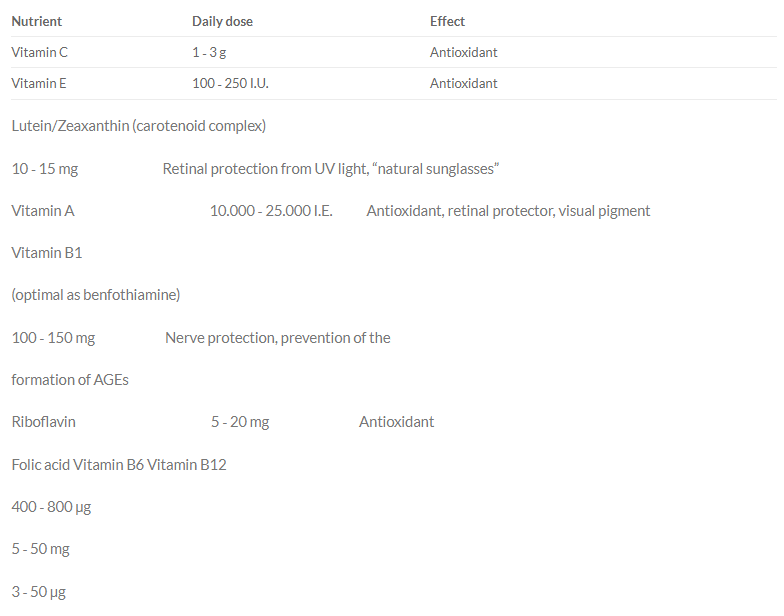
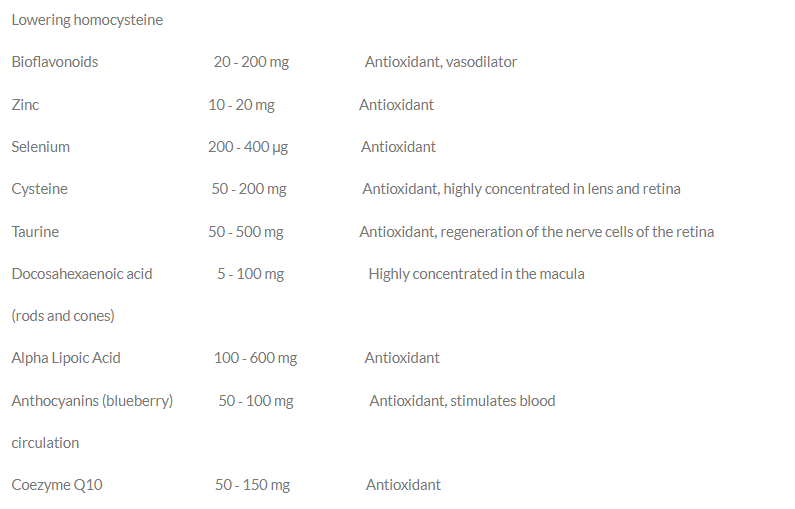
Therapy of incriminating information (pathogenic burdens).
As a rule Ai, with patient no longer at the input. Test out time and amplification. Organs of excretion must always be open.
Poisoning with heavy metals
Recent investigations prove an accumulation of cadmium in the choroid and retina and es‐ pecially in the pigment layer. There, the heavy metal exerts a negative effect on zinc me‐ tabolism. On the one hand, this results in faster aging of the retinal cells with loss of func‐ tion, and on the other hand in a disturbance of the vitamin A conversion to visual purple. Both are processes that cause or worsen macular degeneration. Heavy metals such as mercury (amalgam), palladium, etc. should also be consistently eliminated.
Poisoning with pesticides
Studies from Japan, India and the USA meanwhile prove clear connections between the intake of pesticides and the development of macular degeneration in humans. As a conse‐ quence, contact with pesticides should be avoided as far as possible in any
case, both in food intake and in domestic use.
Caution:
Wood preservatives and insect sprays contain similar compounds, as well as drugs such as cytostatics, antibiotics.
All information burdening the body should be eliminated after testing, including the main allergens.
5.Stabilization of the patient’s eyes
Input cup: Blood, saliva, tear fluid
Output cup: BICOM minerals Storage device: Chip Input: Flexible eye applicator connected with 2 black cables Output: Modulation mat on the back
Stick chip on thymus and take BICOM Minerals 6 drops 3x daily depending on symptoms.
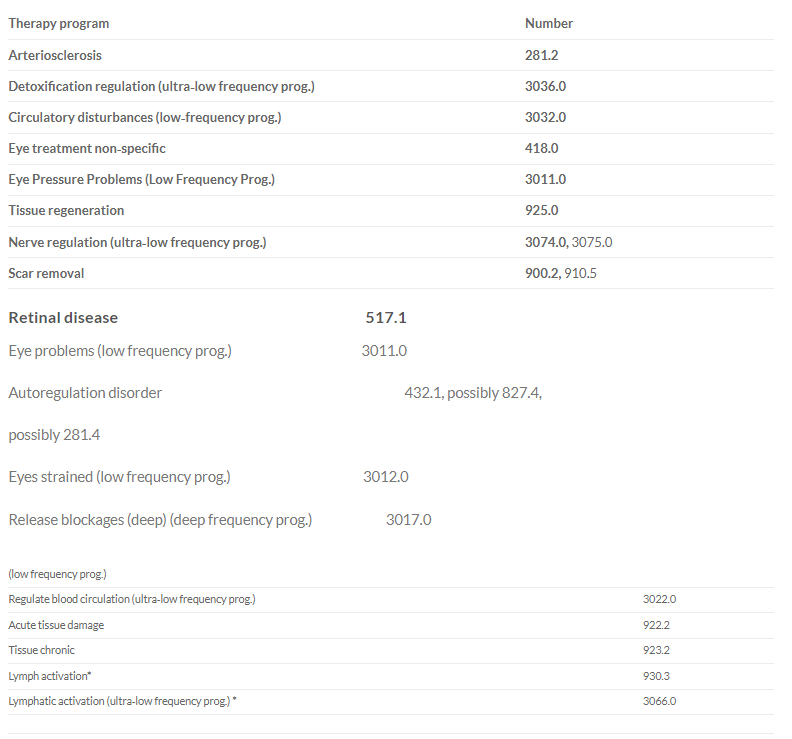
Regulation, general (stress reduction physical)
3084.0
* These frequencies must not be used especially in cases of the wet form and in acute de‐ terioration!
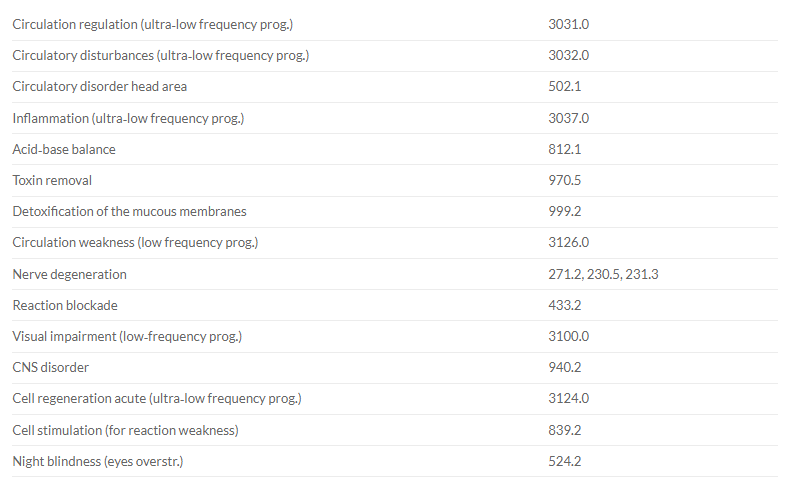
Dry macular degeneration
Standard treatment of dry macular degeneration with flexible eye applicator or with knob applica‐ tor for single eye treatment.
Please note: the red cable was only used to extend the black input cable.
In our practice, the round adhesive applicators have proven to be advantageous. They are at‐ tached to the patient’s closed eyelid without having previously made the upper eyelid grease‐free. Fasten the push‐button adapter of the special cable before sticking and fix the special cable to the patient’s forehead so that no tensile forces are created on the adhesive applicator.
From our experience with our numerous patients with AMD, various programs have been used. The ones in bold have been used most frequently in this application area and have thus proven their worth.
In case that one eye is affected by wet macular degeneration, no blood flow stimulating measures should take place on this eye. In this situation, one can treat the eyes separately with a knob appli‐ cator.
Substance complexes, standard macular degeneration
The appendix contains substance complexes that can be used after testing. Channel 2: stabilizing ampules from the 5 elements box
Earth: organ degeneration, sense organs, metabolism
Metal: colon
Water: kidneys, lymph, teeth
Wood: liver, gallbladder and bile ducts, yin‐yang balance, chemical stress, impaired elimi‐ nation, intercellular tissue stressed, acute or chronic stress
Fire: circulation, small intestine
Channel 2 can also be used to run organ preparations from the company vitOrgan or Heel.
Neurophysiology of the central visual system
The direct projection from the retina to the primary visual cortex is via glial cells. These specialized neurons can be particularly well treated via the lowest frequencies and other brain‐stimulating
herapy program numbers.
In deep frequency therapy the brain is involved, because the eyes and certain centers of the brain are closely connected and constantly influence each other.
The brain is the intelligent control center for eye health. It controls the metabolism, blood flow and nerve function of the eyes.
Treatment with ultra‐low frequencies specifically leads to activation of the macula via the visual center in the brain and can be used for both dry and wet macular degeneration. If possible, ultra‐ low frequencies should always be included in the therapy.
Possible therapy program numbers can be viewed in the appendix and tested out individually for each patient.
Ultra‐low frequency programs used locally on the eye for macular degeneration: BICOM optima:
Program 3
Start category 1 (lowest frequencies) with selection
Testing for the patient individually
The following programs are designed to stimulate the visual cortex and excite the neurons of the visual pathway and visual cortex:
Vegetative dysfunction 4
Autoregulation 1, 827.4, 281.4
CNS disorder 2
Activation of the right hemisphere of the brain 0
Left brain activation 0
Laterality disorder 2
Closing words
AMD is a disease in which the active cooperation of the patient is inevitable.
Patients with macular degeneration are treated weekly in our practice until all risk factors are eliminated. Local eye treatment is also performed during each treatment. Possible therapy pro‐ grams are tested out.
A substance complex always runs alongside the main therapy and stabilizing ampules from the 5‐ Elements kits are also used in channel 2.
Thereafter, treatments continue at 3‐4 week intervals, including general detoxifying therapies.
An important information for our AMD patients is also the information brochure, which is at‐ tached.
Success of treatment with the BICOM method for AMD
Patients react differently to bioresonance therapy, and therefore the reaction sets in differently from patient to patient.
Based on the large number of patients we have already treated, we can say that bioresonance therapy represents a comprehensive therapy option for AMD and also releases many additional healing potentials. An absolute prerequisite for the success of the treatment is the early start of treatment at the stage of dry AMD. If one intervenes at this stage, the transition to wet macular degeneration can be prevented or delayed for a long time. Our goal is to treat the patient holisti‐ cally in order to improve and permanently stabilize vision without risks and side effects.
In our practices, we as therapists are called upon to develop the appropriate foresight, recognize the risk factors, educate patients accordingly, and initiate treatment early.
Your patients will thank you for it. I hope that you were able to recognize the therapeutic ap‐ proach through my explanations about AMD. I wish you and your patients’ good luck.
Stay healthy in body and soul.
Yours Brigitte Jonczyk
Literature and image credits can be requested at praxis@b‐jonczyk.de.
Appendix
BICOM optima
Programs 2: Individual therapy, low frequencies 3003.0 Defense increase
3012.0 Eyes strained
3011.0 Eye problems
3017.0 Unblock
3019.0 Blood pressure too high 3020.0 Blood pressure regulation
3064.0 Liver‐bile regulation
3067.0 Tonsillitis, angina
3074.0 Nerve regulation 1st program 3075.0 Nerve regulation 2nd program 3077.0 Nervous system stressed 3078.0 Kidney function weakness
3021.0 Improve blood values 3022.0 Regulate blood circulation 3031.0 Circulation regulation
3032.0 Circulatory disorder
3036.0 Detoxification regulation
3037.0 Inflammations
3079.0 Renal function weakness 2nd prog. 3080.0 Kidney regulation
3084.0 Regulation general.
3086.0 Oxygen regulation
3089.0 Mucosal regulation 3093.0 Shock treatment acute
3040.0 Tissue regeneration 3053.0 Immune system regulate 3054.0 Jaw problems
3061.0 Stimulate circulation
3062.0 Circulatory weakness, dizziness 3063.0 Liver detoxification
3094.0 Shock treatment 1st program 3095.0 Shock treatment 2nd program 3100.0 Visual impairment
3106.0 Metabolic disorder 1st program 3107.0 Metabolic disorder 2nd program 3108.0 Thymus activation
3109.0 Acidification
BICOM optima
Substance complexes
Arteriosclerosis Macular degeneration Structure seniors male
Structure seniors female Load amalgam (depot)
Exposure to amalgam (fillings) Load cadmium
Improve intestinal flora Candida albicans Diabetes
Small intestine autoimmune dysbiosis Energetic fitter
Energetic fitter nerves
Load DDT Exposure mercury Load nitrogen Palladium load
E‐smog Immunodeficiency Liver support
Information brochure for patients
See your eye doctor regularly from the age of 50 onwards
Do not smoke ‐ passive smokers are also at risk
Avoid regular alcohol consumption
Eat a balanced and wholesome diet (vitamins, trace elements, essential amino acids, lin‐ seed oil)
Pay attention to your acid‐base balance
Wear sunglasses when exposed to sunlight
Avoid short‐wave light (e.g. xenon lamps, computer screens and energy‐saving lamps)
Exercise regularly
Make sure your blood glucose level is well controlled
Lower your blood pressure if you suffer from high blood pressure
Avoid severe overweightness
Make sure you don’t come into contact with pesticides, either in your own garden or in the food you eat
Avoid air pollution (ozone, nitrogen dioxide)
Avoid stress and extreme physical strain
Certain medications may have an unfavorable effect (e.g. acetaminophen, cytostatics, some antibiotics)
